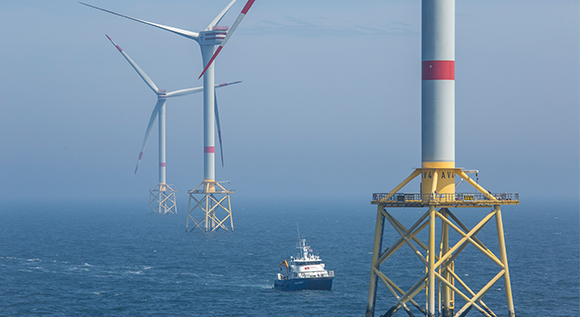Expansion of renewable energy: next round of auctions for offshore wind energy launched
Auctions have provided for more competition on the renewable energy market. As a result, funding rates are plummeting. For offshore wind energy, they have even gone down as low as zero in some rounds. Now, the 2018 round of auctions is set to begin. Expectations are high.
 © BMWi/Holger Vonderlind
© BMWi/Holger Vonderlind
The German government provides funding for the generation of renewable energy. The Bundesnetzagentur is responsible for setting the level of funding that operators receive. Since 2017, these rates have been determined by auction. The basic principle is that funding will go to those who demand the least. During an auction, operators of renewables installations bid the amount of funding they need to generate biogas, wind or solar energy in an profitable manner. The lowest bid wins. The transition from fixed funding rates set by the government to competitive auctions ensures that the expansion of renewable energy continues in a controlled manner and at the lowest possible cost.
Funding for offshore wind energy farms falls to zero
Offshore wind farms which win an auction will not only receive funding for every kilowatt-hour they generate: they will also be given a connection to the grid, which is needed for them to feed the electricity into the grid. The first round of auctions, which took place in 2017, clearly showed that for many offshore wind farm operators, being connected to the grid is far mort important than receiving funding: Three of the four winning bidders did not ask for any funding – they bid 0.00 cents per kilowatt-hour (ct/kWh). The economic success of the three wind farms hinges on being connected to the public grid and on the electricity prices that bidders think they can achieve on the electricity market later on.
With three of the winning projects awarded zero funding, and the fourth project awarded 6 ct/kWh, the average funding rate for all of the four projects is as low as 0.44 ct/kWh. As new technology is making wind turbines more efficient and auctions are leading to more competition between operators, the electricity generated by offshore wind farms is becoming ever more affordable. This is good news for all consumers of electricity, who are paying part of the funding via the renewable energy surcharge.
Germany currently has 20 offshore wind farms and 1,169 wind turbines operating in the North and Baltic Sea. These have a maximum capacity of around 5,400 megawatts – the same as four large coal-fired power plants. By 2030, this figure is to reach 15,000 megawatts – almost three times the capacity of today.
‘Baltic Sea quota’ introduced for the second round
The Bundesnetzagentur has now started the second round of auctions for offshore wind farms. “By holding auctions, we are ensuring the continuous and effective expansion of wind energy,” said Jochen Homann, President of the Bundesnetzagentur. “This is the second time – after last year – that we are holding a competitive auction for offshore wind energy in which the winners will not only be awarded the level of funding they have bid, but are also connected to the public grid.” The 2018 round of auctions deviates from the 2017 round in two ways. First of all, a quota has been introduced, requiring that part of the winning projects be located in the Baltic Sea. This quota has been introduced in response to all of the winning projects in 2017 having been located in the North Sea. The wind farms located in the North Sea are already generating so much electricity that at times, not all of it can be fed into the north German grid, and removing the bottlenecks is expensive. It therefore makes sense to expand wind energy also in the Baltic Sea, even though the level of funding needed by operators there might be higher. In practice, the ‘Baltic Sea quota’ means that of around 1,600 megawatts of new capacity up for auction, at least 500 megawatts need to be installed in the Baltic Sea. In addition to this, the maximum level of funding has been adjusted. In the 2018 round, the bids placed by the operators must not be any higher than 10 ct/kWh. This has been reduced from 12 ct/kWh in the 2017 round.
Important deadlines
Investors who meet the requirements for taking part in the auction have until 3 April 2018 to submit their bid to the Bundesnetzagentur in Bonn. The deadlines for the auctions for onshore wind energy, solar and biomass installations have also been set.

